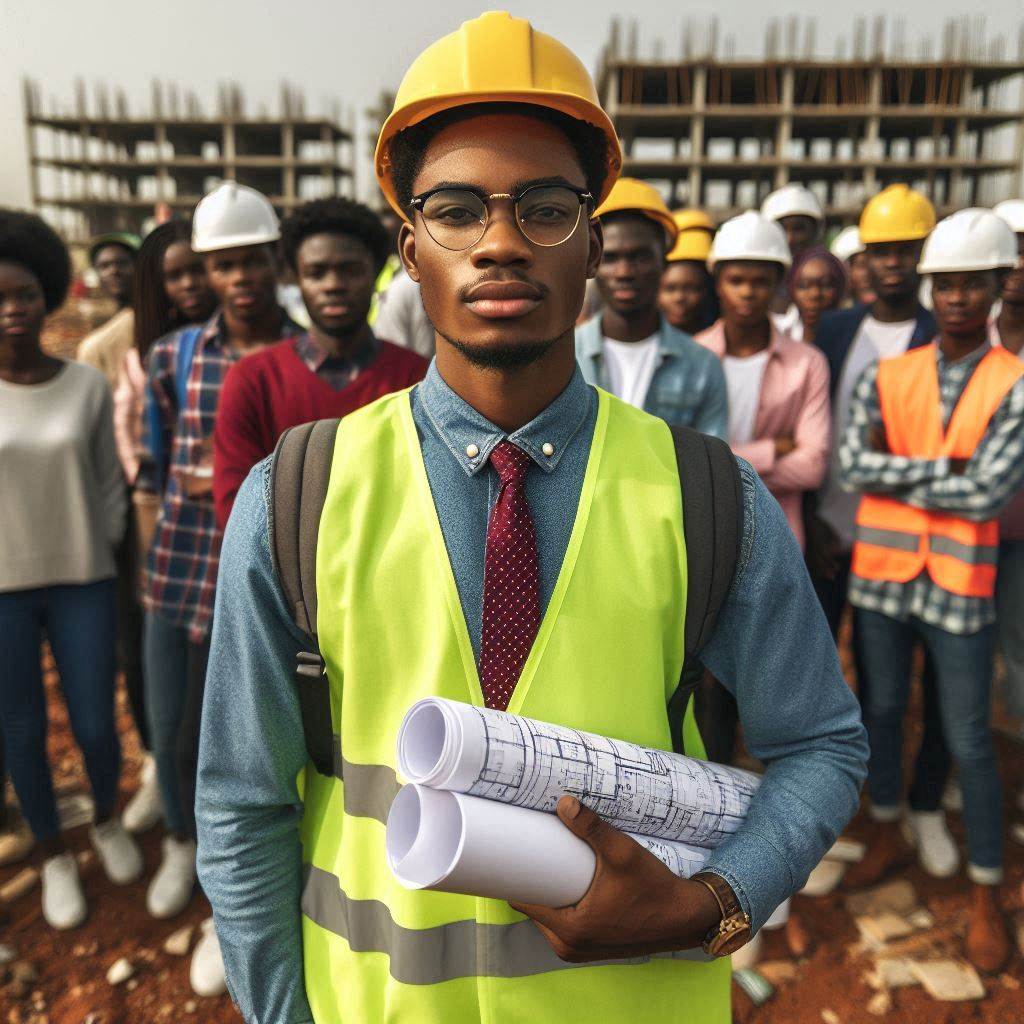Introduction
The construction industry in Nigeria has witnessed significant changes over the years. These changes reflect the nation’s economic growth and technological advancements.
In this section, we will explore the evolution of construction technology in Nigeria.
Brief Overview of the Construction Industry in Nigeria
Nigeria’s construction industry plays a vital role in its economy. The industry encompasses residential, commercial, and industrial projects.
It also includes infrastructure development such as roads, bridges, and airports. The Nigerian construction industry has grown rapidly in the past decades, driven by urbanization and population growth.
However, the industry faces challenges such as regulatory issues, funding constraints, and inadequate skilled labor.
Despite these challenges, the construction sector remains a critical component of Nigeria’s economy. It contributes significantly to GDP and employment.
The industry attracts both local and foreign investments, which boost economic growth. The government also prioritizes infrastructure development, recognizing its importance in national development.
Importance of Construction Technology in Infrastructure Development
Construction technology is crucial for efficient and sustainable infrastructure development. It enhances project quality, reduces costs, and shortens completion times.
Advanced technologies also improve safety and minimize environmental impact. In Nigeria, adopting modern construction technology is essential to meet the growing infrastructure demands.
Innovative technologies such as Building Information Modeling (BIM), prefabrication, and advanced materials have revolutionized construction.
These technologies enable better planning, design, and execution of projects. They also promote resource efficiency and sustainability, which are critical for long-term development.
The adoption of such technologies in Nigeria is gradually increasing, reflecting a positive trend.
Thesis Statement on the Evolution of Construction Technology in Nigeria
The evolution of construction technology in Nigeria signifies a transformative journey. It showcases advancements from traditional methods to modern, innovative techniques.
This evolution highlights the industry’s adaptation to global trends and the nation’s commitment to sustainable development.
In this section, we will delve deeper into the specific technologies that have shaped Nigeria’s construction landscape. We will examine the impacts of these technologies on project efficiency, quality, and sustainability.
Additionally, we will explore the challenges and opportunities associated with the adoption of advanced construction technology in Nigeria.
The future of Nigeria’s construction industry depends on embracing modern technology. As the industry continues to evolve, it will play a crucial role in national development.
By leveraging advanced technologies, Nigeria can achieve its infrastructure goals and enhance economic growth.
Essentially, the construction industry in Nigeria has undergone significant transformation. The adoption of modern construction technology is vital for meeting infrastructure demands.
The evolution of construction technology in Nigeria reflects the industry’s progress and potential for sustainable development.
Through continuous innovation and adaptation, Nigeria’s construction industry will continue to thrive and contribute to the nation’s growth.
Traditional Construction Methods in Nigeria
Overview of Traditional Construction Methods in Nigeria
Nigeria boasts a rich history of traditional construction methods. These methods reflect the diverse cultural heritage and environmental conditions across the country.
One prevalent method is the use of mud and thatch. Mud houses, called “Huts” or “Tukulors,” are common in rural areas. These structures use locally sourced materials like clay, straw, and timber.
Another traditional method involves the use of adobe bricks. These bricks are made from a mixture of earth, water, and organic materials. Sun-drying hardens them before construction.
This method is particularly popular in northern Nigeria. The adobe bricks provide excellent thermal insulation, keeping interiors cool in the scorching heat.
In the southern regions, timber construction is prevalent. Communities near forests use timber and bamboo extensively. Palm leaves and raffia are used for roofing.
These materials are abundant and renewable, making them a sustainable choice.
Challenges Faced with Traditional Methods
Traditional construction methods in Nigeria face numerous challenges. One significant issue is the durability of materials. Mud and thatch structures are prone to weather damage.
Heavy rains and strong winds can quickly degrade these buildings, leading to frequent repairs.
Fire hazards are another concern. Thatch roofs are highly flammable, posing a significant risk to residents. This risk is exacerbated in closely packed settlements where fires can spread rapidly.
Structural integrity is a further challenge. Traditional methods often lack the engineering precision of modern techniques. This can result in buildings that are structurally unsound, posing safety risks to occupants.
Moreover, these methods struggle to meet the demands of urbanization.
As Nigeria’s population grows and urban areas expand, there is a need for more robust infrastructure. Traditional methods are often slow and labor-intensive, making them less suitable for large-scale projects.
Impact on Infrastructure Development
The reliance on traditional construction methods has significant implications for infrastructure development in Nigeria. One major impact is on the quality of housing.
In rural areas, many homes are built using these traditional methods, leading to substandard living conditions. Poor durability and structural issues contribute to this problem.
Transportation infrastructure is also affected. Traditional methods are not suitable for building modern roads, bridges, and railways. This limits the development of efficient transport networks, which are crucial for economic growth.
Additionally, public buildings and facilities suffer. Schools, hospitals, and government offices built using traditional methods often require frequent maintenance.
This diverts resources away from other critical areas, hampering overall development efforts.
However, traditional methods have cultural and historical significance. They reflect Nigeria’s heritage and offer sustainable building solutions.
With appropriate modifications, these methods can be integrated into modern construction practices. Combining traditional knowledge with modern technology can create structures that are both resilient and culturally relevant.
Basically, while traditional construction methods in Nigeria have limitations, they also hold potential.
Addressing their challenges and integrating them with modern techniques can support sustainable and inclusive infrastructure development.
Read: Digital Learning Platforms in Nigeria
Introduction of Modern Construction Technology
Nigeria has witnessed significant advancements in construction technology over the years. These changes have revolutionized the construction industry, boosting efficiency and quality.
The introduction of modern construction technology in Nigeria
The introduction of modern construction technology in Nigeria marked a new era. Traditional methods were gradually replaced by innovative techniques and tools. This shift began in the mid-20th century and has continued to evolve.
Influence of Colonialism on Technological Adoption
Colonialism played a pivotal role in Nigeria’s adoption of modern construction technology. The British colonial administration introduced many new technologies to Nigeria. These technologies were initially used for administrative buildings and infrastructure projects.
Post-independence, these technologies spread to the private sector, influencing local construction practices. The colonial influence facilitated access to advanced construction materials and techniques. It also led to the training of Nigerian professionals in modern construction methods.
Examples of Modern Construction Technologies
Concrete and Steel Structures
Concrete and steel became widely used in Nigerian construction during the colonial era. These materials replaced traditional mud and thatch. They provided greater durability and structural integrity.
Prefabrication
Prefabrication technology was another significant introduction. It allowed for the mass production of building components. These components could be assembled on-site, reducing construction time and costs.
Advanced Machinery
The introduction of advanced machinery revolutionized construction processes in Nigeria.
Cranes, bulldozers, and excavators made large-scale projects feasible. These machines improved efficiency and reduced the reliance on manual labor.
Modern Road Construction Techniques
Modern road construction techniques, including asphalt paving and concrete roads, were introduced.
These techniques improved the quality and longevity of Nigerian roads. They also facilitated better transportation networks across the country.
High-Rise Buildings
The advent of high-rise buildings marked a significant technological advancement. Skyscrapers and multi-story buildings became feasible with new engineering techniques.
These buildings catered to the growing urban population and commercial needs.
Impact on the Construction Industry
The adoption of modern construction technology had a profound impact on the Nigerian construction industry. It led to the growth of the sector, attracting investments and creating jobs.
Quality and safety standards improved, ensuring better-built environments.
Modern technology also encouraged local innovation and adaptation. Nigerian engineers and architects began incorporating local materials with modern techniques.
This blend created unique, culturally relevant, and sustainable construction solutions.
In short, The introduction of modern construction technology in Nigeria marked a transformative period. Colonial influences played a crucial role in this transition.
Today, Nigeria continues to advance, integrating cutting-edge technologies in its construction practices. These advancements promise a brighter future for the country’s infrastructure and built environment.
Read: Educational Tech Startups in Nigeria
Adoption of Sustainable Construction Practices in Nigeria
The Shift Towards Sustainable Construction Practices
The construction industry in Nigeria is evolving rapidly. Traditional methods are giving way to sustainable practices. Builders and developers increasingly embrace eco-friendly techniques and materials.
This shift is essential for reducing the environmental impact of construction activities. Sustainable construction practices minimize waste, reduce carbon footprints, and promote energy efficiency.
One major factor driving this change is global environmental awareness. Nigerian stakeholders recognize the importance of sustainability in construction.
Government policies and regulations also play a crucial role in this transition. The Nigerian government encourages sustainable practices through various incentives and guidelines.
These measures ensure that new projects adhere to environmental standards.
Additionally, international partnerships and collaborations have influenced this shift. Nigerian construction firms collaborate with foreign experts to learn sustainable practices.
These collaborations help integrate global best practices into local projects. The adoption of green technologies and renewable energy sources is becoming commonplace.
Importance of Sustainable Construction in Nigeria
Sustainable construction is vital for Nigeria’s future. It addresses critical issues like environmental degradation and resource depletion.
By adopting sustainable practices, Nigeria can protect its natural resources. This approach ensures the preservation of forests, water bodies, and wildlife habitats.
Sustainable construction also offers economic benefits. Energy-efficient buildings reduce operational costs significantly. Lower energy consumption translates to reduced utility bills for homeowners and businesses.
Additionally, sustainable projects often qualify for financial incentives and tax breaks.
Transform Your Career with Expert Guidance
Get personalized mentorship consulting that’s tailored to your unique path. Our expert advice is actionable and exclusive.
Get StartedHealth and well-being are other critical considerations. Sustainable buildings provide healthier living and working environments.
They use non-toxic materials, improve air quality, and enhance natural lighting. These features contribute to the well-being of occupants and increase productivity.
Moreover, sustainable construction practices can create job opportunities. The demand for green construction professionals and skilled labor is rising.
Training programs and certifications in sustainable construction are gaining popularity. These programs equip workers with the skills needed for the green economy.
Examples of Sustainable Construction Projects in Nigeria
Several notable sustainable construction projects have emerged in Nigeria. One example is the Eko Atlantic City project in Lagos. This ambitious project focuses on creating a sustainable urban environment.
It includes green buildings, renewable energy solutions, and efficient waste management systems.
Another example is the Abuja Green City initiative. This project aims to develop a sustainable and eco-friendly city.
It incorporates energy-efficient buildings, extensive green spaces, and smart infrastructure. The Abuja Green City is a model for future urban development in Nigeria.
The Lagos State Government has also undertaken several green projects.
The Lagos Energy City project promotes renewable energy and sustainable construction. It aims to create a hub for green businesses and eco-friendly technologies.
In addition, private developers are investing in sustainable housing projects. These projects focus on affordability and environmental sustainability. They utilize recycled materials, rainwater harvesting systems, and solar power.
In a nutshell, the adoption of sustainable construction practices in Nigeria is gaining momentum. It is driven by environmental concerns, economic benefits, and international influences.
Sustainable construction is essential for Nigeria’s future, offering numerous advantages. Several exemplary projects showcase the potential of sustainable development in the country.
Read: Tech-Enhanced Learning in Nigerian Schools

Integration of Digital Technology in Nigerian Construction
Embracing Digital Transformation
Digital technology is transforming the construction industry in Nigeria. Companies are adopting various digital tools to enhance operations.
This shift is revolutionizing project management, design, and construction processes. The integration of digital technology is not just a trend; it is a necessity for modern construction.
Enhancing Efficiency and Accuracy
Digital technology significantly improves efficiency and accuracy in construction projects. Digital tools streamline workflows, reducing time and cost.
They enable real-time collaboration among stakeholders, ensuring everyone is on the same page. These technologies also minimize errors, leading to higher-quality construction outputs.
Building Information Modeling (BIM)
Building Information Modeling (BIM) is a game-changer in Nigerian construction. BIM creates a digital representation of the building process.
It allows for better planning, design, and management of construction projects. BIM’s 3D models help in visualizing the project before actual construction begins, reducing errors and rework.
Drones for Site Surveys
Drones are increasingly used in construction for site surveys and inspections. They provide aerial views and high-resolution images of construction sites.
This technology helps in accurate mapping and monitoring of construction progress. Drones save time and reduce the need for manual surveys.
Mobile Technology for On-Site Management
Mobile technology is vital for on-site management in construction. Smartphones and tablets enable real-time communication and data sharing among workers.
Mobile apps help in tracking project progress, managing resources, and documenting issues on the go. This technology enhances on-site productivity and efficiency.
Advanced Construction Software
Construction software like Procore and PlanGrid is widely used in Nigeria. These platforms offer comprehensive project management solutions.
They help in scheduling, budgeting, and document control. Construction software ensures that projects are completed on time and within budget.
Internet of Things (IoT)
The Internet of Things (IoT) is making construction sites smarter. IoT devices collect and transmit data from various site activities.
This data helps in monitoring equipment usage, tracking material inventory, and ensuring safety compliance. IoT enhances overall site management and operational efficiency.
3D Printing in Construction
3D printing is an emerging technology in Nigerian construction. It allows for the creation of complex structures with precision and speed.
3D printing reduces waste and labor costs, making construction more sustainable. This technology is particularly useful for building affordable housing.
Augmented Reality (AR) and Virtual Reality (VR)
AR and VR are transforming how construction projects are visualized and managed. AR overlays digital information onto the physical world, aiding in project visualization.
VR creates immersive environments for virtual walkthroughs and design simulations. These technologies improve decision-making and client engagement.
In fact, The integration of digital technology in Nigerian construction is reshaping the industry. From BIM to drones, mobile technology, and IoT, these tools enhance efficiency, accuracy, and productivity.
As digital adoption continues, the future of construction in Nigeria looks promising and innovative. Embracing these technologies is crucial for staying competitive in the evolving construction landscape.
Read: Nigerian Curriculum Studies Academic Journals
Challenges Faced in Implementing New Technology
In Nigeria’s construction industry, the journey towards modernization encounters significant hurdles. Identifying these challenges is crucial for progress.
Lack of Skilled Labor and Expertise
Skill shortages plague the sector, hindering the smooth integration of advanced construction technology.
Finding adequately trained workers remains a persistent struggle for firms striving to embrace innovation.
Limited access to quality education exacerbates the problem, leading to a dearth of proficient professionals.
Without skilled labor, the potential benefits of new technology cannot be fully realized, stalling industry growth.
Investment in vocational training programs is essential to bridge the gap and cultivate a competent workforce.
Financial Constraints in Adopting New Technology
Financial barriers pose another formidable challenge in the adoption of modern construction techniques in Nigeria.
Acquiring state-of-the-art machinery and equipment demands substantial capital, often beyond the reach of many firms.
High initial costs deter companies, especially smaller ones, from investing in innovative technologies.
Additionally, ongoing maintenance expenses and the need for periodic upgrades add to the financial burden.
Limited access to funding further compounds the issue, restricting the ability of firms to modernize their operations.
Overcoming the Challenges
Addressing these challenges requires a concerted effort from various stakeholders within the construction industry.
Government initiatives aimed at improving vocational education and training can enhance the pool of skilled labor.
Subsidies or tax incentives for firms investing in new technology can alleviate financial burdens and encourage innovation.
Public-private partnerships can facilitate access to funding and technology transfer, fostering industry modernization.
Furthermore, collaborative research and development initiatives can tailor technological solutions to local needs and conditions.
Capacity-building programs, workshops, and seminars can raise awareness and promote the benefits of adopting new technology.
In general, While challenges abound, the potential rewards of embracing modern construction technology in Nigeria are immense.
By addressing skill shortages and financial constraints through strategic interventions, the industry can unlock new avenues for growth and development.
With a proactive approach and collective effort, Nigeria’s construction sector can chart a path towards a more efficient, sustainable future.
Government Policies and Initiatives
Overview of government policies and initiatives to promote the use of new construction technology
The Nigerian government has recognized the importance of adopting new construction technology to drive development in the country.
In line with this, several policies and initiatives have been put in place to promote the use of innovative construction methods.
These policies include providing incentives for companies that incorporate new technologies in their construction projects. This could be in the form of tax breaks or subsidies to encourage the adoption of these advanced techniques.
Additionally, the government has established partnerships with international organizations and technology companies to transfer knowledge and expertise in modern construction methods.
This collaboration has helped to train local professionals and create a conducive environment for the implementation of new technologies.
Importance of government support in driving innovation
Government support is crucial in driving innovation in the construction industry.
By creating a regulatory framework that supports the integration of new technologies, the government can incentivize companies to invest in research and development.
Moreover, government funding and grants can support the testing and implementation of new construction technologies.
This financial assistance can help reduce the risk for companies looking to adopt innovative methods.
Furthermore, government-led initiatives can create awareness about the benefits of new construction technologies and showcase successful projects that have utilized these advancements.
This can inspire other companies to follow suit and accelerate the pace of technological adoption in the industry.
Success stories of government initiatives in improving construction technology in Nigeria
One notable success story is the collaboration between the Nigerian government and international construction companies to introduce prefabrication techniques in housing projects.
This partnership has led to faster construction times and higher quality buildings.
Another example is the establishment of research and development centers dedicated to exploring new construction materials and methods.
These centers have been instrumental in developing innovative solutions that address the unique challenges faced in the Nigerian construction sector.
Additionally, the government’s support for capacity building programs and training initiatives has resulted in a skilled workforce proficient in modern construction technologies.
This has improved the overall efficiency and productivity of construction projects in Nigeria.
In closing, government policies and initiatives play a significant role in shaping the evolution of construction technology in Nigeria.
By fostering a conducive environment for innovation and providing support for the adoption of new technologies, the government can drive sustainable growth and development in the construction industry.
Conclusion
Recap of Evolution
In Nigeria, construction technology has undergone a remarkable evolution. From traditional methods reliant on manual labor to modern techniques utilizing advanced machinery and materials, the journey has been significant.
Importance of Embracing New Technology
The importance of embracing new technology cannot be overstated. It not only enhances efficiency and productivity but also improves safety standards and reduces environmental impact.
Embracing innovation is crucial for sustainable development in Nigeria’s construction sector.
Call to Action
Stakeholders across the construction industry must collaborate to advance technology in Nigeria. This collaboration should involve government bodies, private companies, educational institutions, and research organizations.
Together, they can drive innovation and ensure the widespread adoption of cutting-edge construction technology.
Generally, the evolution of construction technology in Nigeria has been transformative.
From modest beginnings to embracing modern innovations, the sector has made significant strides. However, there is still much room for growth and improvement.
Initially, construction in Nigeria relied heavily on manual labor and traditional building materials such as mud and thatch.
However, with rapid urbanization and increasing demand for infrastructure, the industry began to modernize.
The adoption of new technology in construction is crucial for Nigeria’s sustainable development.
Advanced techniques like prefabrication, 3D printing, and Building Information Modeling (BIM) can revolutionize the sector, making it more efficient and cost-effective.
Stakeholders must recognize the urgency of embracing these innovations.
By investing in research and development, training programs, and incentivizing the use of modern construction methods, Nigeria can position itself as a leader in the global construction industry.
To sum up, the evolution of construction technology in Nigeria is a testament to the country’s resilience and adaptability.
By embracing innovation and collaboration, Nigeria can build a brighter future for generations to come.




